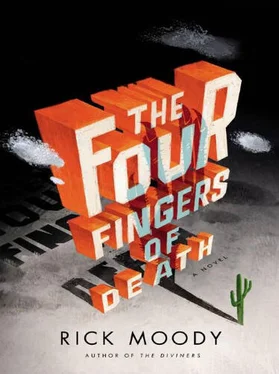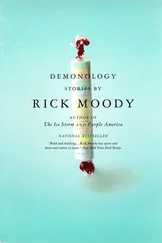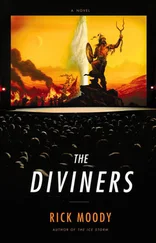The End
Afterword: On The Crawling Hand by Montese Crandall
The Crawling Hand , as directed by Herbert L. Strock and released in 1963, has to be one of the finest films ever made, in this or any other century. Though it cannot be disputed that the acting is somewhat rudimentary, though the sets are ridiculous and look as if they were just pasted up, though the story is capable of causing spasms of laughter, it is, I intend to argue, a masterpiece. Yes, the dialogue is so awkward that it nearly, through ironistic transformation, disarms you into believing that it is something else entirely. Because I have now seen the film twenty-one or twenty-two times, I can recall portions of this dialogue, and because repetition and attention and commitment to even the worst examples of entertainment improve them considerably, these lines have come to assume, for me, yes, the dimensions of poetry :
It’s the press
What do we tell them?
Tell them we just sent
Our second man
To the moon
And he’s not coming back either…
Even the credit sequence is sloppy, in which a mostly dead astronaut, upon returning from the moon, is poised, is frozen, like an unused marionette, before the enormous viewing window of his capsule. There is the crashing of the orchestral cymbals on the soundtrack to indicate the shooting of stars. From a distance of half a century, this credit sequence looks remarkably clumsy, like a film as you might make it at home, except that of course these days homemade films are often widely distributed, and they are some of the most popular and successful films being made in this country.
We don’t pretend to know all the answers…
Apparently no one does.
The sound is dreadful too. Did I say that already? You can scarcely hear what’s being said. Did they not try to improve on that? Did they loop nothing? Everyone smokes too much. Nonstop smoking. The point is this. If The Crawling Hand is one of the sloppiest and most ill-conceived pieces of cinema, which it arguably is, what accounts for its enduring cultural value? Why is it that the film has never vanished into obscurity the way, for example, C.H.U.D . (1984) has vanished into obscurity, or the way Sunspots (2017), that big-budget extravaganza about diaphanous beings from the sun leading the citizens of Earth to their spiritual redemption, has disappeared from cultural memory?
The success of The Crawling Hand has, it should be said, something to do with the arm itself, with the plangent qualities of that sightless limb, and this is just what I was saying to my chess-playing friend D. Tyrannosaurus the day on which we were finally concluding our chess match. The game had proceeded by telephone initially, but in time it became clear that weeks were going to pass before one of us proved victorious. I don’t know who D. was calling for strategic counsel, some working girl perhaps, but he seemed to require much preparation in order to make his moves. We therefore determined that despite the earlier agreements on the subject, we were going to bring the match to fruition in person once again, at the café called Ho Chi Minh.
It was a rout, I don’t have to tell you, because I am really the much better player, though clearly D. Tyrannosaurus, whose actual name was Tyrone (as he had belatedly admitted), had misrepresented his inabilities in order to attempt to throw me off. I had felt, as one often feels in life, let down by Tyrone, and not only because of his name or his chess skills. For example, I once suggested that we go to a minor league baseball game in the Rio Blanco area, where the local affiliate was doing rather well, and that isn’t the sort of thing I would have done had I known his only purpose was to swindle.
I was being taken , you see; that was what it was all about, and I didn’t appreciate being taken , and who would? When I encountered him at the Ho Chi Minh, for the purposes of the endgame, I should say, he had lost much of his luster. Tyrone was no longer attempting to straighten himself up in the way he had before. He had let himself slide. He was just another dreamy con artist. Is it the way of all obsessions that they consume their subjects? Was Tyrone simply tired out from his long boondoggle in the Southwest, attempting to persuade a reputable dealer of baseball cards to give him that one last precious item?
Liftoff from the moon
Perfect.
One hour later
Nothing.
Our match was completed in candlelight, and there was not much to it, and I wish that I could give you an exciting account of the game, in which there was psychological maneuvering in order to gain the upper hand. But this would be to descend into the blandly technical. I will say, though, that I have spent some time considering the sighing of chess players, and have wondered if it might be possible to somehow codify these chess-playing sighs, as though to indicate that certain kinds of sighs can, in particular circumstances, have a strategic role. For example, I noticed that one of the younger Hungarian grand masters, whose name escapes me, was given to a sigh that I came to name the Slow Leak . It didn’t really count as a sigh exactly, and perhaps I am overreaching by even using this word to refer to it. But the Slow Leak is really the perfect description. You know the way some people release a little bit of air, under a certain amount of compression between their teeth, and it’s really exactly like a balloon deflating? This Hungarian grand master had perfected, above all, the deployment of the Slow Leak , which he would use especially when the other player was just about to move, was, perhaps, reaching out to move the piece. In the Hungarian’s matches, the video simulcast would always have a close-up of the faces of the players; you could see the frustration in some of his opponents during the Slow Leak . Their heads rested in their hands.
I did not sigh this particular sigh while playing against Tyrone, but there’s another that is very effective, and this sigh is known as the Appaloosa . This, my friends, is the ugliest of all sighs. It involves letting the lips go free as the air is forced out of the mouth. The Appaloosa is a disruptive, nearly violent sigh in the context of a chess match. It is likely that the first chess player to make use of the Appaloosa was a man from some Western milieu such as the one in which I am writing these lines, where freight trains pass on the half hour and horses are as common as jet packs. This chess player, in whatever century he existed, was used to the snorting of the horses he regularly bred, and perhaps he was acquainted with the Nez Percé and their particular breed, the Appaloosa, and perhaps he had fallen in love with the idiosyncrasies of this particular Appaloosa, its nickering, and despite its tremendous ugliness and the whites of its eyes, which are so arresting, this chess player realized that the snorts of the Appaloosa would be perfect in a very close chess match. The results had to have been good, and so the Appaloosa , the chess-related sigh, went into more common usage, from which it has never since disappeared.
There are other varieties of sighs that work very well in amateur chess, and which have on occasion led to major victories. But the sighs do not work on chess automata, which take no notice of the less-becoming aspects of human behavior. Still, it’s what happens alongside the chessboard that’s interesting; it’s all the gestures that would seem routine or uninteresting to anyone who happened by, that’s where the action is in the chess match. Chess is human relations. But if I must: Tyrone’s opening was the so-called Nimzo-Larsen opening, which, when commonly practiced among, especially, Sino-Indian players, starts first with the knight on the king’s side (to F3), followed by (when an advanced player, like yours truly, elects to develop the center in reply) the pawn at B3, after which we get the fianchetto, or “little flanking.”
Читать дальше












